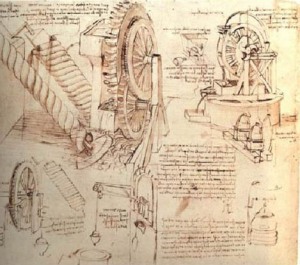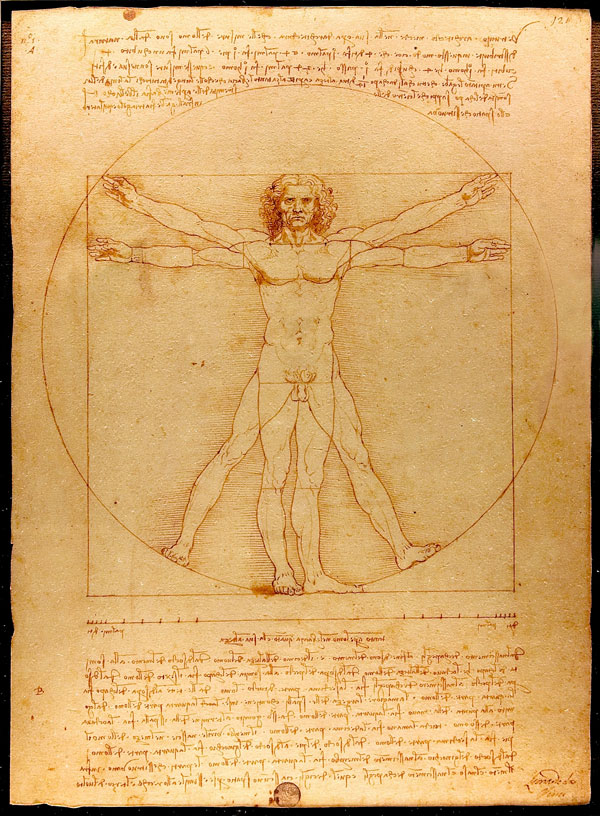After watching a short documentary called ‘The Beauty of Diagrams: Vitruvian Man’ presented by Professor Marcus du Sautoy, I have discovered that the aim of the Vitruvian Man diagram by Leonardo Da Vinci was not just a beautiful drawing but it was to show through science and art the perfection of the human body.
Da Vinci came from a small Tuscan village who constantly travelled like most artists. He worked in many places such as Florence, Mulan and Venice. It is hard to define what he was exactly. Was he an artist? Musician? Botanist? Anatomist? Engineer? Architect? Turns out he was all of these things. He painted the iconic Mona Lisa, designed military hardware and was the first artist to cut open a human body, dissect and draw human organs and bones. He possessed a strong thirst for knowledge: feet, skulls, and hands, hearts, and lungs, muscles, and sinews, buildings, bridges, and machines. He obsessively dissected, drew and examined like no other artist had done before. For him science and art were one. His aim for dissecting and drawing the body obsessively was to find the perfect geometric proportions that ruled the natural world – and God’s greatest creations was man himself.
Da Vinci: ‘Man is the model of the world’
There are so many meanings to the Vitruvian Man diagram. Yes it is about the body and human anatomy but as you look in depth you can see mathematics and geometry. It is in fact a solution to an early arch itectural problem. The problem, about buildings and mans’ proportions. Other artists in the past tried but failed. Da Vinci’s diagram is one which conveys that man is the ideal geometric model for architecture.
Da Vinci’s inspirations came from the classical works on architecture by the Roman writer Vitruvius. Vitruvius said ‘For any building to be beautiful it must have perfect symmetry and proportions like those found in nature’, thus, resulted in Da Vinci’s Vitruvian Man.
The task laid down by Vitruvius was to position a man on his back with arms stretched out and have his fingers and toes touch the circle’s circumference pinpointed on the mans naval and also to plac e the same man inside a square. When observing the Vitruvian Man you can see lines situated on certain places the body. These lines represent the different proportions that the body possess. For example: four fingers make up a palm, six palms make up the distance from the top of the finger to the elbow, then four times the distance from finger to elbow makes up the height of the man. The diagram indicates the proportions of the human body and its link to architecture.
But what does the circle and square mean? They were seen as perfect shapes in nature in the Renaissance. They were also important to Vitruvius. He thought temples were the perfect buildings as they were a close link to God. A square formed the floor and the circle – the dome.
At last, the final layer – movement – captured in Da Vinci’s diagram by the man’s unique double pose. Martin Kemp and graphic designer Steve Maher collaborated and took the task in exploring movement to create an animation. The idea was based upon Da Vinci’s drawings as he sketches sequences poses and a single drawing captures the feeling of movement. He analysed movement like animators would do to understand how beings move. However, Da Vinci did not have the tools to create movement out of his drawings, thus created series of them.
There is a sculpture of the Vitruvian Man in London’s Belgrave Square which captures the diagrams 3D potential. This proves how iconic Da Vinci’s drawing has become. For me, it is not as effective as Da Vinci’s diagram – it looks like there are two men merged together rather than the one man in motion. However it is striking to the eye through its large scale.
I personally can’t think of any other diagram which has had so much publicity and success. The Vitruvian Man has been given a lot of iconic treatment. His drawings are very popular with today’s artists, thus, I think will truly remain an iconic and remembered piece of art for many years to come.








This was a nice article. I love Da Vinci’s work. 🙂
Hey there! I’ve been following your web site for a long time now
and fionally got the courage to go ahead and give you a shout out from Kingwood Tx!
Just wanted too mention keep up the excellent job!